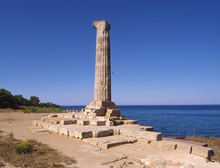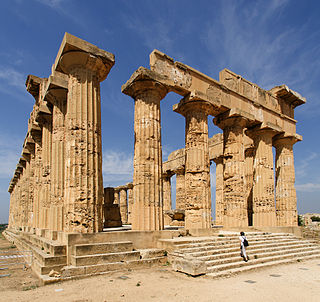
Selinunte was a rich and extensive ancient Greek city of Magna Graecia on the south-western coast of Sicily in Italy. It was situated between the valleys of the Cottone and Modione rivers. It now lies in the comune of Castelvetrano, between the frazioni of Triscina di Selinunte in the west and Marinella di Selinunte in the east.

Magna Graecia is a term that was used for the Greek-speaking areas of Southern Italy, in the present-day Italian regions of Calabria, Apulia, Basilicata, Campania and Sicily; these regions were extensively populated by Greek settlers starting from the 8th century BC.
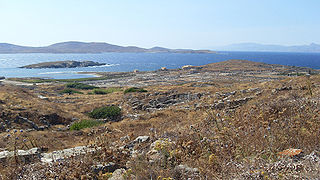
The island of Delos, near Mykonos, close to the centre of the Cyclades archipelago, is one of the most important mythological, historical, and archaeological sites in Greece. The excavations in the island are among the most extensive in the Mediterranean; ongoing work takes place under the direction of the Ephorate of Antiquities of Cyclades, and many of the artifacts found are on display at the Archaeological Museum of Delos and the National Archaeological Museum of Athens.
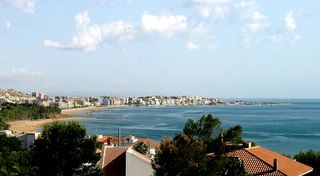
Crotone is a city and comune in Calabria, Italy.

Cape Sounion is the promontory at the southernmost tip of the Attica peninsula, 8 kilometres (5.0 mi) south of the town of Lavrio, and 69.5 km southeast of Athens in the Athens Riviera. It is part of Lavreotiki municipality, East Attica, Greece.

Paestum was a major ancient Greek city on the coast of the Tyrrhenian Sea, in Magna Graecia. The ruins of Paestum are famous for their three ancient Greek temples in the Doric order dating from about 550 to 450 BC that are in an excellent state of preservation. The city walls and amphitheatre are largely intact, and the bottom of the walls of many other structures remain, as well as paved roads. The site is open to the public, and there is a modern national museum within it, which also contains the finds from the associated Greek site of Foce del Sele.

Epizephyrian Locris, also known as Locri Epizefiri, was an ancient city on the Ionian Sea, founded by Greeks coming from Locris at the beginning of the 7th century BC. It is now in an archaeological park near the modern town of Locri.

The province of Crotone is a province in the Calabria region of Italy. It was formed in 1992 out of a section of the province of Catanzaro. The provincial capital is the city of Crotone. It borders the provinces of Cosenza, Catanzaro, and also the Ionian Sea. It contains the mountain Pizzuta, the National Park of the Sila, Montagnella Park, and the Giglietto Valley. Crotone was founded in 710 BCE. It participated in the Second Punic War against the Roman Republic.

Val Camonica or Valcamonica, also Valle Camonica and anglicized as Camonica Valley, is one of the largest valleys of the central Alps, in eastern Lombardy, Italy. It extends about 90 kilometres (56 mi) from the Tonale Pass to Corna Trentapassi, in the commune of Pisogne near Lake Iseo. It has an area of about 1,335 km2 (515 sq mi) and 118,323 inhabitants. The River Oglio runs through its full length, rising at Ponte di Legno and flowing into Lake Iseo between Pisogne and Costa Volpino.

The Heraion of Samos was a large sanctuary to the goddess Hera, on the island of Samos, Greece, 6 km southwest of the ancient city of Samos. It was located in the low, marshy basin of the Imbrasos river, near where it enters the sea. The late Archaic temple in the sanctuary was the first of the gigantic free-standing Ionic temples, but its predecessors at this site reached back to the Geometric Period of the 8th century BC, or earlier. The ruins of the temple, along with the nearby archeological site of Pythagoreion, were designated UNESCO World Heritage Sites in 1992, as a testimony to their exceptional architecture and to the mercantile and naval power of Samos during the Archaic Period.

Pyrgi was originally an ancient Etruscan town and port in Latium, central Italy, to the north-west of Caere. Its location is now occupied by the borough of Santa Severa. It is notable for the discovery here of the gold tablets, an exceptional epigraphic document with rare texts in Phoenician and Etruscan languages, and also the exceptional terracotta pediment statues from the temple.

Capo Colonna is a cape in Calabria located near Crotone. In ancient Roman times the promontory was called Promunturium Lacinium. The modern name derives from the remaining column of the Temple of Hera Lacinia.
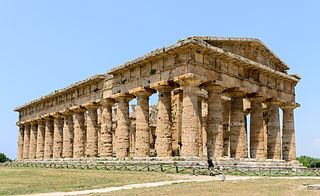
The Temple of Hera II, is a Greek temple of Magna Graecia in Paestum, Campania, Italy. It was built in the Doric order around 460–450 BC, just north of the first Hera Temple of around 550–525 BC. If still in use by the 4th-and 5th century, it would have been closed during the persecution of pagans in the late Roman Empire.
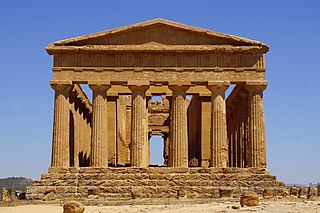
The Valle dei Templi, or Valley of the Temples, is an archaeological site in Agrigento, Sicily. It is one of the most outstanding examples of ancient Greek art and architecture of Magna Graecia, and is one of the main attractions of Sicily. The term "valley" is a misnomer, the site being located on a ridge outside the town of Agrigento.
Krimisa, Crimisa or Crimissa was an ancient town, probably originating in the 7th century BC, situated in modern Calabria in the region of Punta Alice. It was inhabited by an indigenous people assimilated by the Greeks.

Tauriana or Taureana was an ancient city located in present Palmi, Reggio Calabria province.

The Heraion at Foce del Sele is an archaeological site consisting of an Ancient Greek sanctuary complex dedicated to the goddess Hera in what was Magna Graecia. When built, the complex was located at the mouth of the Sele, approximately 8 km (5.0 mi) north of the Greek city of Poseidonia that was famous for its three standing Greek temples. Due to the deposition of alluvial sediment by the river, the site now is approximately 2.3 km (1.4 mi) from the modern coast.

The Tavole Palatine are the remains of a hexastyle peripteral Greek temple of Magna Graecia the 6th century BC, dedicated to the goddess Hera and the god Apollo. The temple, located near the Bradano river in the south of Italy, was part of a countryside sanctuary and remains of the wall of the temenos and of a very ancient altar are visible.

Capo Colonne Lighthouse is situated on the extremity of the Promunturium Lacinium, nearby the single column of the Greek temple elevated in honour of Hera Lacinia, at 9 kilometres (5.6 mi) from Crotone on the Ionian Sea.

The so-called Temple of "Hera", otherwise known as Temple D, is a Greek temple in the Valle dei Templi, a section of the ancient city of Agrigentum in Sicily.
